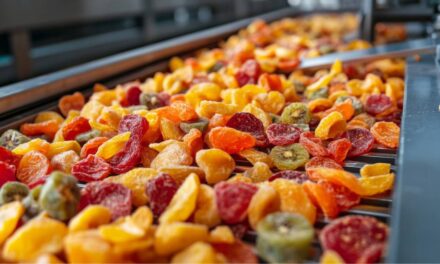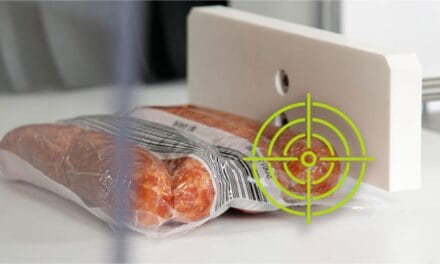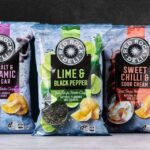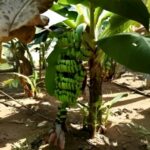Food safety is the first and the foremost necessity in food production. Food has to be safe and healthy for its consumer. He pays for it. O S Gautam explains here Step by Step Hazard Analysis and HACCP as quality management system as a tool to produce safe food.
As we know that food and water are the main sources of contamination and causes of diseases. In an era of educated consumers, globalisation and vigilant regulatory bodies, food that is not safe for human consumption is just not acceptable. Therefore, Food safety is the first and the foremost necessity in food production. Food has to be safe and healthy for its consumer. He pays for it. The intrinsic qualities of food are the attributes that give food its brand value.
Therefore, necessary systems, manufacturing practices and monitoring controls must be instituted throughout the chain of events involved in the food production, storage and supply chain of frozen food.
To produce a good and safe product, the first requirement is a production facility. Location of the plant, construction material, plant lay out to facilitate unidirectional workflow, quality of equipment, manufacturing practices or SOPs (standard operating procedures), personal hygiene of employees, general cleanliness and sanitary procedures (SSOPs-standard sanitary operating procedures), quality of raw materials, handling in different stages of manufacturing, storage, transportation, distribution and retailing, all put together determine the product quality.
Location and Lay-Out of the Production Facility
Food has to be free from all three kinds of contaminations — physical, biological and chemical. Therefore, its location has to be selected accordingly, an environment free from all contaminations. A food factory located near a chemical, fertiliser, pesticide or pharmaceutical company will have its impact on the product directly or indirectly. A food facility located in the vicinity of a tannery or near an open drainage system that discharges and percolates huge amounts of contaminated water is bound to have contaminated groundwater and probably contaminated air too. Therefore, a food manufacturing unit should be located ideally away from the industries and pest infested areas with availability of quality groundwater, easy access to electricity and road.
As we progress forward from raw material to finished product, it is assumed that the product gets cleaner and cleaner in each step. We also know that raw materials in their primary stages are contaminated and need cleaning and primary processing or pre-processing (de-weeding, deseeding, peeling, cleaning, chopping etc.) before they are used as an ingredient. Vegetables may bring in contamination from the farm soil, dust, and pesticides. In contrast, animal products may need bleeding, evisceration, deskinning, descaling, peeling, chopping, portioning etc.
Such activities and the work environment carry a high bacterial load. Therefore, the layout of a food facility should be unidirectional. To avoid cross-contamination, it should also be well segregated to carry out high contamination (low-risk area) and low contamination (high-risk area) activities separately. If a company produces raw and cooked products in the same facility, it may need even further segregation for the raw product (low-risk product) and cooked or ready to eat product (high-risk product). Unidirectional workflow can be designed only when plant lay out has been designed accordingly. Therefore, a plant needs to be designed, and its workflow is finalised only after a product is targeted. Wrongly designed workflow or a plant cannot produce the right product.
Construction Material for Production Facility
Construction material needs to be such that it does not pose a safety issue. Food processing requires high volumes of water, and general atmosphere is humid. Therefore, wooden structures will absorb moisture and harbour microorganisms like bacteria and fungi. Hence no wood is desired inside a food facility. Wood also can splinter and get into food, causing physical contamination. Glasses and plastics are brittle and, once damaged, can scatter in a wider area and may pose a threat to the consumer as a contaminant in food. Therefore, glasses and plastics should also be avoided as a building material in a food facility. Roofing materials like asbestos are well-known carcinogenic substances and pose a health issue for the employees, not to be used.
Construction material for a food facility should be made from non-absorbent, easy to clean, non-corrosive materials. Structures made of iron, galvanised iron, and aluminium get oxidised and rusted in due course due to high humid conditions and become a source of contamination. Therefore their use, especially in the food production area, is to be avoided or suitably treated/ coated so that they do not corrode. Paints used on the walls, surfaces and equipment should be of high quality and should not peel off; otherwise, they may make their way into food.
Therefore, the company has to have its policies in relation to the use of glass, plastics, wood and environmental issues like disposal of wastewater, smoke, hazardous gases etc. and social issues like children employment, smoking amongst employees, noise pollution etc., in companies GMP or any other quality manual and adhered to.
Food Safety: HACCP as Quality Management Tool
Food safety and quality management systems aim to prevent hazards from happening. They have a proactive approach to foresee opportunities for hazards and plug them from taking place. There are several quality management systems in the foray to manage safe food production, i.e. ISO-22000, ISO 9000-2000, HACCP, SQF, BRC, etc. It could be a matter of debate which system is better than others; however, HACCP is the core of all quality management systems and the most practical way to produce safe and quality food. Therefore, in this article, we will talk about the HACCP quality management system as a tool to produce safe food.
HACCP (Hazard Analysis and Critical Control Point) is preventive management based on seven basic principles.
- Prepare workflow or flow chart of a product step by step. Analyse each step for chances of all the three types of contaminations- biological, physical and chemical.
- Establish the critical step critical to the quality of food (if not controlled, will certainly lead to health hazard to consumers) or critical control point or CCP.
- Establish its permissible limits beyond which food is not safe for consumption.
- Establish parameters (what), methodology (how), frequency (when) and authority (who). (What to be Checked, How to be Checked, When to be Checked and Who will Check).
- Establish corrective action procedures when a violation takes place.
- Records of monitoring
- Verification procedure- to check that monitoring and controls are effective and no product is produced with violated CCP.
It does not mean that one has to control only CCP in a food factory. There are so many important factors to be monitored, i.e. recipe, taste, shape, colour and outer appeal, weight, packing, sealing, labelling, storage and transportation, etc. They may not cause any health hazard to a consumer; however, they are very much required to keep up the food quality. Therefore, in general terms, we call them “Control Points“. If not controlled or allowed to happen, the parameters that may lead to health hazards are called “Critical Control Points“.
To understand it properly, we take an example of a plant producing frozen “Ready to Eat Breaded and Battered Veg Burger“.

Case Study: Ready to Eat Breaded and Battered Veg Burger
Although Hazard Analysis must be conducted for each step of the workflow involved in food production, to understand the process of hazard analysis, we will analyse four steps 1- Raw material (vegetable) receiving 2- Battering and 3- Frying or cooking 4- Freezing.
Step-1 Vegetable Receiving
Chemical Hazard: There are chances that the farmer has used insecticide or pesticide in his farm to protect his crop from pest infestation, and harvested crop may contain remains of pesticide. This can cause health problems for consumers, and there is no chance of eliminating it in any way in and during the further processing step. Therefore, this is a critical point and must be controlled at this step, and contaminated vegetables with pesticides should not be allowed to get into production. Therefore, screening vegetables for pesticides at raw material receiving is a CCP.
It may not be possible to check every day every lot for insecticides as it is a time-consuming process. Therefore, it could be better than before harvesting, one sample is drawn from the standing crop in the farm itself, and supply should be permitted once it is found free of pesticides. In addition, a guarantee in writing should be obtained from the farmer that he hasn’t / will not use in the future course any pesticide and his farm output are free from it.
Other specifications of vegetables for freshness, maturity, ripeness, rottenness, damage etc., should also be checked as per the specification of a species and accepted only when found suitable for consumption.
Biological Hazard: Vegetables may bring in microbial contamination from the farm soil, dust and fungal infections from their own. Tubers and vegetables with roots carry heavy bacterial loads from the farm soil. However, steps further in the workflow like washing, blanching, and final cooking will take care of bacterial contamination by washing them off and killing them during thermal treatment (blanching and cooking process). Therefore, this step may be a control point and not a CCP. Whereas final cooking process must be a CCP as any slip in this step may cause pathogenic organisms in the food to survive, causing infection and suffering to the consumer.
Physical Hazard: Vegetables may bring in sand and stone particles along with them. They may be wooden chips from the wooden chest they were packed and transported and sometimes accidentally even glass and metallic pieces. However, it is supposed that they will be removed during washing, cleaning and screening during further processing steps and ultimately metal detection. Therefore, this may be considered a control point but not a CCP at the raw material receiving step. However, metal detection, which is the last step in the flow chart, if slipped, the product may carry metal contamination which may pose a physical health hazard to the consumer during eating (physical damage to teeth or mouth). After ingestion to the internal organs, therefore metal detection should be considered a CCP.
Step-2 Battering
Chemical Hazard: In this step, chilled water is added to batter powder to prepare batter solution, and this solution is applied over the product for further breading. Because clean water is used and the batter does not contain any chemicals, therefore, no chemical hazard is anticipated at this step.
Biological Hazard: Batter powder is generally a mixture of wheat flour, sometimes maise flour, sodium bicarbonate and gums (hydrocolloids). All are food grade, but flour generally contains Staphylococcus aureus as a natural contaminant. Unclean or improperly cleaned batter mixer or batter applicator machine also can be a source of Staphylococcus. Humans themselves are a reservoir of Staphylococcus bacteria that live over the skin, hairs, and inside the nose and throat of humane beings. Once hydrated, staphylococci start multiplying and produce toxins in the batter. Staphylococcus toxin is known to cause food poisoning.
Therefore, the temperature of the batter must always be kept below 10 degree Celsius as the multiplication of Staphylococcus is arrested or slowed down at lower temperatures. Also, the fresh batter is regularly prepared and applied to replenish used stock. This step is a CCP as once toxin is formed, there is no way to remove or nullify it. The only way is to arrest its production by keeping batter temperature low.
Physical Hazard: There are chances that some nut or bolt or even a piece from the conveyor belt of the battering machine comes out and contaminates food; however, there is metal detection at the end of the process, which will eliminate this hazard if any, therefore at this step no physical hazard in seen.
Step-3 Frying or Cooking
Chemical Hazard: No chemical hazard is anticipated at this step as only edible oil, free from preservatives and chemicals, is used for cooking. However, some people may be allergic to peanuts and mustard oil. Therefore, if they are used for cooking, they should be labelled on the packaging.
Biological Hazard: Frying is a cooking method where oil is used as a cooking medium. Its temperature is raised to 165 to 185 degrees, and the product is emersed inside the oil till it turns golden brown. Core temperature reaches 80 degree Celsius as the product is Ready To Eat and may not be cooked further except that it may be mildly heated at the time of eating.
Therefore, food must be cooked thoroughly so that bacteria and other microbes are eliminated and enzymes inactivated. As this is the only time when the product will go through the thermal process and if not done properly, microorganisms may survive and cause infection to the consumer. Therefore, this stage is a CCP and time and temperature should be controlled so that the temperature reaches a minimum of 80 degree Celsius in the core. Food is considered cooked when the core of the product reaches 80 degree Celsius.
Physical Hazard: There are chances that some part of the cooking vessel or any nut bolt or conveyor part gets into food, but metal detection will address them. Therefore, this is not a CCP at this stage.
Step-4 Freezing
Chemical Hazard: Product is sent inside the freezer either in a lot (like blast and contact freezers) or continuously in belt freezers. There is no application of any chemical in the process. Therefore, no chemical hazard is foreseen in this step.
Biological Hazard: Temperature inside the freezer is very low, say -30 to -40 degree Celsius, and no bacteria can multiply at this temperature.
However, if food is not frozen to – 18 degree Celsius at its core, putrefactive activities (microbial, enzymatic and oxidative) may keep progressing at a slow pace. Therefore, this is a very important Control Point, or even it can be considered a CCP.
Physical Hazard: Any metal piece getting into food from the freezers or supporting equipment will be eliminated during METAL DETECTION; hence no physical hazard is anticipated at this step.
In this way, each and every step of workflow should be analysed, and a comprehensive list of CCPs and CPs should be developed along with control measures for online monitoring.
ALSO READ:
Using Steam Correctly in HACCP Based Manufacturing
Photos by freepix.com
















